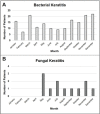Etiology and Risk Factors for Infectious Keratitis in South Texas
- PMID: 32308946
- PMCID: PMC7151511
- DOI: 10.18502/jovr.v15i2.6729
Etiology and Risk Factors for Infectious Keratitis in South Texas
Abstract
Purpose: To determine the causative organisms and associated risk factors for infectious keratitis in South Texas.
Methods: This retrospective study was performed at a tertiary teaching hospital system in South Texas. Medical records of all patients who presented with infectious keratitis from 2012 to 2018 were reviewed. Only patients with culture-proven bacterial, fungal, and Acanthamoeba keratitis were included.
Results: In total, 182 eyes of 181 patients had culture-proven bacterial, fungal, or Acanthamoeba keratitis. The age of patients ranged from 3 to 93 years, with a mean of 48.3 20.8 years. The most common etiologic agent was bacteria, with 173 bacterial cultures (95.1%) recovered, followed by 13 fungal cultures (7.1%), and 3 Acanthamoeba cultures (1.6%). Of the 218 bacterial isolates, coagulase-negative Staphylococcus was the most common (25.7%), followed by Pseudomonas aeruginosa (23.4%), Staphylococcus aureus (11.0%), and Moraxella (7.8%). Fusarium was the most common fungal isolate (46.2%). The most common risk factors for infectious keratitis included contact lens wear (32.4%), underlying corneal disease (17.6%), trauma (14.3%), and ocular surface disease (13.7%).
Conclusions: Bacteria are the most common cause of infectious keratitis in this patient population, with coagulase-negative Staphylococcus and Pseudomonas as the most common isolates. The prevalence of culture-positive fungal keratitis is significantly lower than that of bacterial keratitis. Contact lens wear is the most common risk factor associated with infectious keratitis in South Texas.
Keywords: Bacteria; Corneal Ulcer; Fungus; Keratitis; Acanthamoeba.
Copyright © 2020 Puig et al.
Conflict of interest statement
There are no conflicts of interest.
Figures
Similar articles
-
Risk factors and causative organisms in microbial keratitis.Cornea. 2008 Jan;27(1):22-7. doi: 10.1097/ICO.0b013e318156caf2. Cornea. 2008. PMID: 18245962
-
Microbial keratitis in Sao Paulo, Brazil: a 10-year review of laboratory results, epidemiological features, and risk factors.Arq Bras Oftalmol. 2023 Oct 20;87(6):e202200660. doi: 10.5935/0004-2749.2022-0060. eCollection 2023. Arq Bras Oftalmol. 2023. PMID: 37878874 Free PMC article. Review.
-
Predisposing factors and etiologic diagnosis of ulcerative keratitis.Cornea. 2008 Apr;27(3):283-7. doi: 10.1097/ICO.0b013e31815ca0bb. Cornea. 2008. PMID: 18362653
-
Bacterial and Fungal Keratitis in a Tertiary Care Hospital from Romania.Microorganisms. 2024 Apr 12;12(4):787. doi: 10.3390/microorganisms12040787. Microorganisms. 2024. PMID: 38674731 Free PMC article.
-
Infectious keratitis: A review.Clin Exp Ophthalmol. 2022 Jul;50(5):543-562. doi: 10.1111/ceo.14113. Epub 2022 Jun 3. Clin Exp Ophthalmol. 2022. PMID: 35610943 Free PMC article. Review.
Cited by
-
Do Ophthalmic Solutions of Amphotericin B Solubilised in 2-Hydroxypropyl-γ-Cyclodextrins Possess an Extended Physicochemical Stability?Pharmaceutics. 2020 Aug 19;12(9):786. doi: 10.3390/pharmaceutics12090786. Pharmaceutics. 2020. PMID: 32825121 Free PMC article.
-
Citrobacter keratitis: predisposing factors and clinical characteristics.J Ophthalmic Inflamm Infect. 2023 Jan 31;13(1):3. doi: 10.1186/s12348-022-00322-1. J Ophthalmic Inflamm Infect. 2023. PMID: 36720767 Free PMC article.
-
Association between Moraxella keratitis and advanced glycation end products.Sci Rep. 2024 Apr 5;14(1):8024. doi: 10.1038/s41598-024-58659-7. Sci Rep. 2024. PMID: 38580798 Free PMC article.
-
Aetiology and antibiotic susceptibility of bacterial keratitis at a referral centre in southern Sweden.Sci Rep. 2025 Jun 20;15(1):20123. doi: 10.1038/s41598-025-04404-7. Sci Rep. 2025. PMID: 40542031 Free PMC article.
-
Microbial Keratitis Isolates at a Midwestern Tertiary Eye Care Center.Cornea. 2023 Dec 1;42(12):1488-1496. doi: 10.1097/ICO.0000000000003198. Epub 2023 Jan 27. Cornea. 2023. PMID: 36716402 Free PMC article.
References
-
- Mcleod Stephen D., Kolahdouz-Isfahani Amir, Rostamian Khodam, Flowers Charles W., Lee Paul P., Mcdonnell Peter J. The Role of Smears, Cultures, and Antibiotic Sensitivity Testing in the Management of Suspected Infectious Keratitis. Ophthalmology. 1996;103(1):23–28. doi: 10.1016/s0161-6420(96)30738-0. - DOI - PubMed
-
- Rk Forster. Conrad Berens Lecture. The management of infectious keratitis as we approach the 21st century. CLAO J 1998;24:175–180. - PubMed
Publication types
LinkOut - more resources
Full Text Sources

